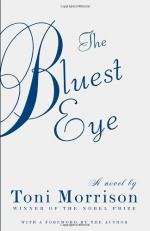
|
| Name: _________________________ | Period: ___________________ |
This test consists of 15 multiple choice questions and 5 short answer questions.
Multiple Choice Questions
1. Mrs. MacTeer exclaims during her diatribe in Part II, “I got about as much business with another mouth to feed as a cat has with” what?
(a) “A top hat.”
(b) “Side pockets.”
(c) “A wristwatch.”
(d) “A wheelbarrow.”
2. Of what dancer does Claudia say in Part II “was my friend, my uncle, my daddy, and who ought to have been soft-shoeing it and chuckling with me”?
(a) Chuck E. White.
(b) Bojangles.
(c) Fred Astaire.
(d) Louis Armstrong.
3. The narrator in Part I says that at first they thought there were no marigolds that fall because Pecola was what?
(a) Having her father’s baby.
(b) Planning to kill her father.
(c) Praying for bad weather.
(d) Depressed about life.
4. What does Jane’s father do when Jane asks him to play in the story from Part I?
(a) He gets mad.
(b) He smiles.
(c) He cries.
(d) He says he is too busy.
5. What is the name of Pecola’s brother in the novel?
(a) Sammy.
(b) Woodrow.
(c) Fowler.
(d) Henry.
6. The author states in the novel's Foreword, "There can't be anyone, I am sure, who doesn't know what it feels like to be" what "momentarily or for sustained periods of time"?
(a) “Disembodied and alienated.”
(b) “Victimized, or traumatized.”
(c) “Disliked, even rejected.”
(d) “Villain-ized or victimized.”
7. The author states in the book's Foreword that when one is "hated for things we have no control over and cannot change," it is some consolation to know what?
(a) That the hatred is unjustified.
(b) That the hatred is accurate.
(c) That the hatred is justified.
(d) That the hatred is not accurate.
8. The author states in the Foreword that her concept of breaking the narrative of the novel into parts "didn't work" because many readers "remain touched but not" what?
(a) “Moved.”
(b) “Informed.”
(c) “Guilty.”
(d) “Enlightened.”
9. What is Mr. Henry’s last name?
(a) Whitcomb.
(b) Washington.
(c) Dunion.
(d) Yacobowski.
10. The narrator in Part I says that for years she believed the reason the marigolds didn’t bloom was because she had done what?
(a) Planted them too deep.
(b) Over-watered them.
(c) Planted them too shallow.
(d) Under-watered them.
11. What is the narrator of Part II’s sister’s name?
(a) Rosemary Villanucci.
(b) Maureen Peal.
(c) Pecola Breedlove.
(d) Frieda MacTeer.
12. How old is Sammy when he lives by the pizza parlor in the narrator’s description from Part II?
(a) 7.
(b) 11.
(c) 6.
(d) 14.
13. Where is Pecola’s father when she goes to stay with the MacTeer family in Part II?
(a) In the hospital.
(b) In Europe.
(c) In jail.
(d) In Mexico.
14. According to Toni Morrison in the book’s Foreword, “The extremity of Pecola's case stemmed largely from" what?
(a) “A crippled and crippling family.”
(b) “A series of bad choices.”
(c) “The poorest of luck.”
(d) “Societal pressures.”
15. What does Pecola’s mother demand that Pecola’s father get out of bed and go get for her in their argument in Part II?
(a) Milk.
(b) Eggs.
(c) Flour.
(d) Coal.
Short Answer Questions
1. What pet does Jane first attempt to play with in the story from Part I?
2. The narrator states in Part II, “The only living thing in the Breedloves' house was” what?
3. The narrator states in Part II, “The Breedloves did not live in a storefront because they were having temporary difficulty adjusting to the cutbacks at the plant. They lived there because they were poor and black, and they stayed there because they believed” what?
4. In speaking of Pecola’s father in Part I, the narrator says, “Our innocence and faith were no more productive than his” what?
5. In Part II, the narrator says that “drunken men with sober eyes sing in the lobby” of what hotel?
|
This section contains 628 words (approx. 3 pages at 300 words per page) |

|




